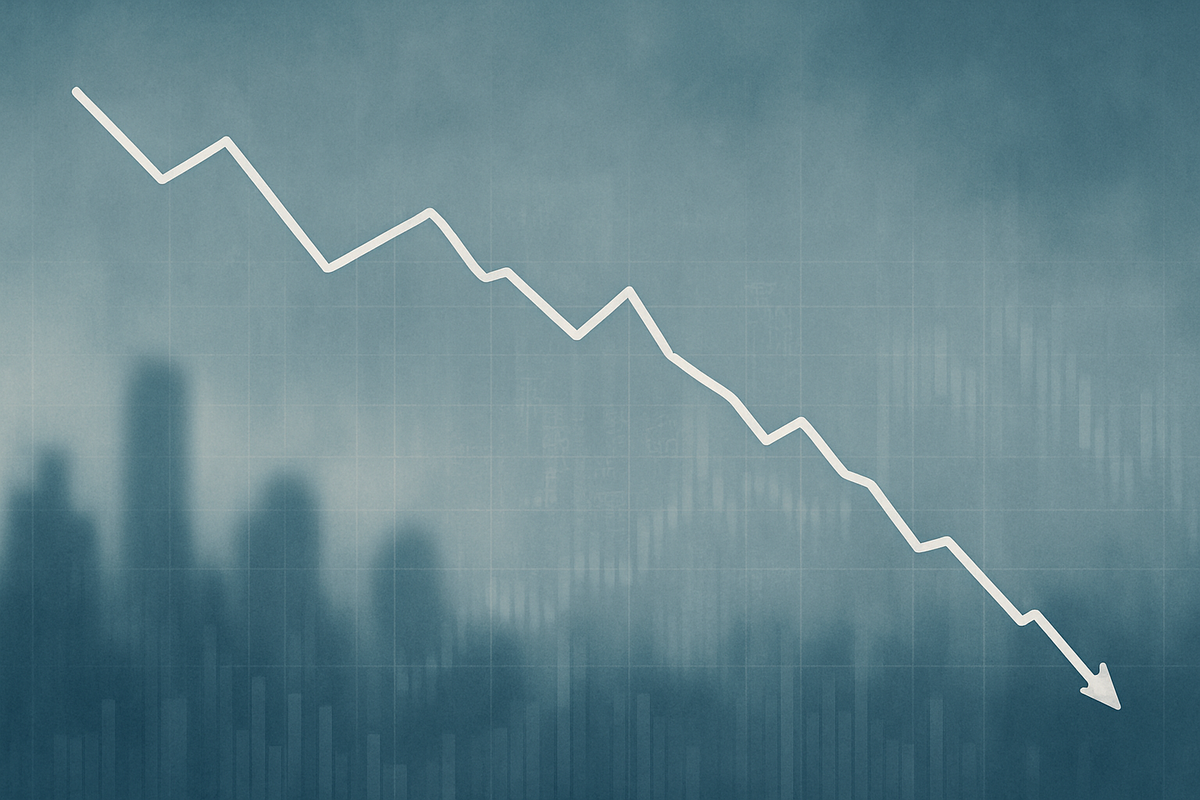
The U.S. Leading Economic Index (LEI) has experienced a consistent decline in recent months, sparking concerns about the nation's economic trajectory for the second half of 2025. While the current economic activity, as measured by the Coincident Economic Index (CEI), shows some resilience, the persistent downward trend in the LEI suggests a weakening outlook. This raises a critical question: is the U.S. economy heading for a recession, or is this merely a signal of a significant slowdown?
The immediate implications of this LEI dip are a projected deceleration in economic growth and consumer spending. Businesses and consumers alike are bracing for a potentially tougher economic environment, with the specter of tariffs and higher prices looming large. The coming months will be crucial in determining whether these early warning signs translate into a full-blown economic contraction or a more manageable period of slower growth.
The LEI's Persistent Slide and Its Underlying Causes
The U.S. Leading Economic Index, a key barometer of future economic activity, has been on a downward trend, signaling a potential weakening of the economy in the latter half of 2025. In July 2025, the LEI (NYSE: LEI) registered a 0.1% decrease to 98.7 (2016=100), following a 0.3% decline in June. This marks a more rapid contraction over the six-month period from January to July 2025, with a 2.7% fall, compared to the 1.0% decline in the preceding six months. This acceleration in the rate of decline from the second half of 2024 to the first half of 2025 is particularly noteworthy.
Several factors are contributing to this downward pressure. Consumer expectations regarding future business conditions have remained consistently pessimistic, reflecting a lack of confidence in the economic outlook. New orders in the manufacturing sector have also been weak, a consequence of a broader global manufacturing slowdown. While initial unemployment claims showed a slight improvement in July, they had previously contributed negatively to the index. Furthermore, a decrease in building permits has added to the LEI's woes. Interestingly, stock prices have been a lone positive contributor, providing some counteracting support to the index.
The Conference Board, which publishes the LEI, anticipates a weakening of the U.S. economy in the second half of 2025, largely due to the increasing visibility of negative impacts from tariffs. They project real GDP growth to decelerate to 1.6% year-over-year in 2025, further slowing to 1.3% in 2026. Consumer spending is also expected to slow down as higher prices continue to impact purchasing power. This confluence of factors paints a picture of an economy facing significant headwinds.
Despite the LEI's decline, the Coincident Economic Index (CEI), which reflects the current state of the economy, showed a 0.2% rise in July 2025. Most components of the CEI, including payroll employment, personal income less transfer payments, and manufacturing and trade sales, demonstrated improvement, with industrial production being the sole exception. This suggests that while forward-looking indicators point to a slowdown, the current economic activity is still experiencing some growth, creating a nuanced economic landscape.
Navigating the Economic Headwinds: Potential Winners and Losers
The anticipated economic slowdown, signaled by the declining LEI, will undoubtedly create a mixed bag of fortunes for public companies across various sectors. Companies with strong balance sheets, diversified revenue streams, and essential product or service offerings are likely to be more resilient, while those heavily reliant on discretionary consumer spending or facing significant exposure to tariffs may struggle.
On the winning side, companies in defensive sectors such as utilities, healthcare, and consumer staples may see increased stability. For instance, utility providers like NextEra Energy (NYSE: NEE) or healthcare giants such as Johnson & Johnson (NYSE: JNJ) often experience more consistent demand regardless of economic fluctuations. Similarly, consumer staples companies like Procter & Gamble (NYSE: PG), which produce everyday necessities, tend to perform relatively well during economic downturns as consumers prioritize essential purchases. Furthermore, companies that offer cost-saving solutions or services that help businesses optimize operations during leaner times could also thrive. Technology companies specializing in efficiency-enhancing software or automation, for example, might find new opportunities.
Conversely, companies heavily dependent on consumer discretionary spending are likely to face significant challenges. Retailers of luxury goods, travel and leisure companies, and automotive manufacturers could see a substantial drop in demand as consumers tighten their belts. For example, cruise line operators like Carnival Corporation (NYSE: CCL) or high-end fashion brands may experience reduced sales. Companies with significant international exposure, particularly to regions impacted by global manufacturing slowdowns or trade tensions, could also be negatively affected. Additionally, businesses with high debt levels or those that rely heavily on easy access to credit may find themselves in a precarious position as interest rates potentially remain elevated or even rise further in a slowing economy.
The manufacturing sector, already grappling with weak new orders and a global slowdown, could see further contraction. Companies like General Electric (NYSE: GE), with diverse manufacturing operations, will need to carefully manage their supply chains and production to adapt to reduced demand. Construction companies, impacted by the decrease in building permits, may also face headwinds. Real estate developers and homebuilders, such as D.R. Horton (NYSE: DHI), could experience a slowdown in new home sales and construction projects. Investors will be closely watching corporate earnings reports and forward-looking guidance for signs of how these economic pressures are impacting individual companies.
Broader Implications and Historical Context
The persistent decline in the U.S. Leading Economic Index (LEI) is not an isolated event but rather fits into broader industry trends of global economic uncertainty and inflationary pressures. This event underscores the interconnectedness of the global economy, where a slowdown in one major economic power can have ripple effects across continents. The anticipated weakening of the U.S. economy, driven in part by tariffs, highlights the ongoing challenges of trade protectionism and its potential to disrupt established supply chains and dampen international commerce.
The potential ripple effects extend beyond direct competitors to partners and suppliers. Companies that rely on robust consumer demand in the U.S. for their products or services, whether domestically or internationally, could see their revenues impacted. For instance, technology companies that supply components to U.S. manufacturers or logistics firms that facilitate trade could experience a slowdown in business. Regulatory and policy implications are also significant. Governments may face increased pressure to implement fiscal stimulus measures or adjust monetary policy to counteract the economic slowdown. Debates around trade policies and tariffs are likely to intensify, with businesses advocating for stability and predictability.
Historically, consistent declines in the LEI over several months, particularly when the index falls below its peak level from 6-12 months prior, have often preceded recessions. The "3Ds rule" for signaling an impending recession, which considers the six-month diffusion index and the LEI's six-month growth rate, has been triggered multiple times in recent months. In July, the six-month diffusion index remained at 40%, a level historically associated with economic contractions. However, it is crucial to remember that the LEI is not an infallible predictor, and there have been instances of "false positives" where a downturn was indicated but a recession did not materialize. For example, there have been periods in the past where the LEI signaled a slowdown that ultimately proved to be a soft landing rather than a full-blown recession.
Comparing the current situation to similar events in the past, such as the periods leading up to the 2001 dot-com bust or the 2008 financial crisis, reveals both similarities and differences. While the LEI showed declines in those periods, the underlying causes and the broader economic context were distinct. Today's economic landscape is characterized by unique challenges, including persistent inflation, geopolitical tensions, and the lingering effects of the pandemic, making direct comparisons complex. The current situation demands a nuanced understanding of the various contributing factors rather than a simplistic reliance on historical patterns.
What Comes Next: Navigating the Uncertain Economic Landscape
The coming months will be critical in determining the trajectory of the U.S. economy. In the short term, businesses and consumers should prepare for continued economic headwinds, including slower growth and potentially higher prices. Companies may need to implement strategic pivots, focusing on cost optimization, supply chain resilience, and innovation to maintain competitiveness. This could involve re-evaluating investment plans, streamlining operations, and exploring new markets or product lines that are less susceptible to economic downturns.
Long-term possibilities include a prolonged period of slower growth, often referred to as a "soft landing," where the economy avoids a full-blown recession but experiences a significant deceleration. Alternatively, if the negative factors intensify, a recession remains a distinct possibility. Market opportunities may emerge for agile companies that can adapt quickly to changing consumer preferences and economic conditions. For instance, businesses offering essential services or products that provide value and affordability during challenging times could see increased demand. Conversely, challenges will persist for sectors heavily reliant on discretionary spending or those vulnerable to trade disputes.
Potential scenarios and outcomes range from a gradual recovery in late 2025 or early 2026, assuming inflationary pressures ease and global trade stabilizes, to a more protracted downturn if economic indicators continue to worsen. The Conference Board, while acknowledging the LEI's recession signals, currently does not project a full recession, anticipating a weakening of the economy rather than a contraction. This suggests a scenario where the economy slows significantly but avoids a technical recession. However, this outlook is contingent on various factors, including the effectiveness of monetary and fiscal policies, and the evolution of global economic conditions.
Investors should closely monitor key economic indicators beyond the LEI, such as inflation rates, employment figures, consumer confidence surveys, and corporate earnings reports. The Federal Reserve's monetary policy decisions will also play a crucial role in shaping the economic outlook. Companies that demonstrate strong financial health, adaptability, and a clear strategy for navigating a challenging economic environment will likely be better positioned to weather the storm and emerge stronger.
Conclusion: A Cautious Outlook Amidst Shifting Economic Tides
The recent decrease in the U.S. Leading Economic Index (LEI) serves as a significant warning sign, pointing towards a weakening economic outlook for the second half of 2025. While a full-blown recession is not currently projected by The Conference Board, the persistent decline in the LEI, coupled with pessimistic consumer expectations and weak manufacturing orders, suggests a period of slower growth and increased economic uncertainty. The "3Ds rule" for signaling an impending recession has been triggered multiple times, underscoring the seriousness of the current economic signals.
Key takeaways from this event include the importance of forward-looking indicators like the LEI in anticipating economic shifts, the interconnectedness of global trade and its impact on domestic economies, and the need for businesses and individuals to prepare for potential economic headwinds. The market moving forward is likely to be characterized by increased volatility and a greater emphasis on resilience and adaptability. Companies with strong fundamentals and strategic foresight will be better positioned to navigate the challenges and capitalize on emerging opportunities.
Investors should remain vigilant, closely monitoring not only the LEI but also a broader range of economic data, including inflation, employment, and consumer spending. The actions of central banks and governments in response to the evolving economic landscape will also be crucial. While the immediate future may present challenges, a nuanced understanding of the economic signals and a proactive approach to financial planning will be essential for both businesses and individuals in the coming months. The ultimate significance and lasting impact of this LEI dip will depend on how effectively policymakers and market participants respond to these early warnings.




